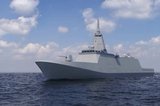Germany highlights AI and uncrewed systems in mistakenly released naval force structure plans
The German Navy ship Brandenburg participates in Exercise Steadfast Defender 2021. (Photo: US DoD)
In a now-deleted web post, the Bundeswehr detailed how the German Navy must prepare for future conflicts, describing the shape of its fleet and a need for large numbers of uncrewed systems.
The Bundeswehr wrote: 'The navy must become fit for the future of naval warfare. It requires a large number of unmanned systems and requires artificial intelligence, in particular for situational awareness and analysis.
'In order for this to become a reality, two things are important: 1. The path to the future of the naval forces must be sustainably financed. 2. It is already important to test the use
Already have an account? Log in
Want to keep reading this article?
More from Naval Warfare
-
![Future of the Canadian Patrol Submarine Project is still unclear]()
Future of the Canadian Patrol Submarine Project is still unclear
The Canadian government remains tight-lipped on the timeline and funding required for the next steps of its Canadian Submarine Patrol Project, which should offer improved capabilities for the country’s navy.
-
![Mitsubishi eyes future with Australia’s Mogami selection]()
Mitsubishi eyes future with Australia’s Mogami selection
With Australia’s selection of the Mogami-class for Project Sea 3000, Mitsubishi is investigating local production in the next decade as potential export opportunities emerge.
-
![Thales’ new Sonar 76Nano could equip UK Royal Navy on anti-submarine warfare missions]()
Thales’ new Sonar 76Nano could equip UK Royal Navy on anti-submarine warfare missions
The new sonar is designed to equip uncrewed underwater vessels, with the potential to be used by the Royal Navy for its Atlantic Bastion and Atlantic Net missions.
-
![Hanwha wins Australian government approval to increase its stake in Austal]()
Hanwha wins Australian government approval to increase its stake in Austal
The contract would mean the two shipbuilders can collaborate strategically and enhance shipbuilding capabilities in Western Australia.























